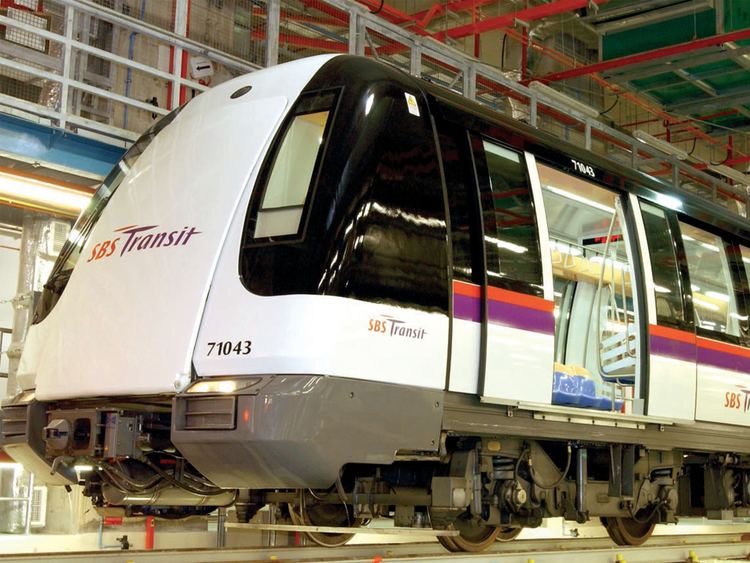In service 20 June 2003– Constructed 2000–2001 | Entered service 2003 | |
 | ||
The Alstom Metropolis C751A trains are the first generation of communication-based train control (CBTC) rolling stock that has been in service in Singapore's Mass Rapid Transit on the North East Line since 2003. 25 trainsets were purchased for the line.
Contents
Overview
The six-car trains on the North East Line are powered by overhead catenary, a first in Singapore's MRT history. Rolling stock on all the other operating lines are powered by a third rail because authorities considered overhead wires to be unsightly and did not allow for trains to be powered using this method on elevated lines. Since this line is the first to be fully underground in Singapore, the authorities had a choice between powering the trains on this line by overhead catenary or third rail. This rolling stock is the first to have seats of the same colour in every compartment of the train.
Alstom was contracted in 1997 and 1998 (as Contract C751A) by the Land Transport Authority (LTA) in Singapore to supply for trains for the North East Line.
Announcements
The announcements for the North East Line differ from those on MRT lines operated by SMRT, i.e. a different announcer. The "doors closing" announcements and chime are taken from old announcements introduced in 1994 for the North South and East West Lines. Upon arrival at train stations, a "Please Mind the Gap" announcement would be made in four languages. "Please do not Lean Against the Doors" and several safety announcements are occasionally broadcast to commuters.
Exterior Design
The exterior design is using two windows in front and behind and uses SBS Transit placing on the emergency door. Along the train they uses Red and Purple stripes to know that this is operated by SBS Transit. The fleet numbers was placed above at the door on the roof on 1st and 4th doors on each carriage and they placed the SBS Transit logo three per side per carriage. C751A trains do not have the window to see which was mostly used on latest driverless trains.
Interior Design
Inside the train, above the door and the seats the colour is Beige Colour. And the doors were in Blue, the communication for emergency uses in Beige colour with the SBS Transit logo. The seats were in Lavender and Beige seats across all carriages. And the wheelchairs was placed between 9th and 16th carriages and they have 24 LCD display each train but they were deactivated. The major difference from latest Driverless trains is that they uses two windows in front, however no end side have no windows at the emergency door which only introduced at C830 trains. However at each end they only have 1 area to look at the tunnel viewing, this is because this line uses Overhead lines, they have the gearbox to be used for Overhead Lines. However, when they view the driver will be applied to be used during peak hours, the passengers may have difficulty viewing the train in front and behind.
Driverless operation
The C751A is the first fully driverless heavy metro rolling stock in Singapore. Nonetheless, SBS hires employees trained to drive the trains manually if necessary.
Communications-based Train Control (CBTC), which maintains a "continuous two-way digital communication" between each controlled train and a wayside control center, which may control an area of a railroad line, a complete line or a group of lines help track the trains' positions. Recent studies consistently show that CBTC systems reduce life-cycle costs for the overall rail property and enhance operational flexibility and control.
Experimental Programmes
Train Formation
The configuration of a C751A in revenue service is DT-Mp-Mi-Mi-Mp-DT
The car numbers of the trains range from 7x001 to 7x050, where x depends on the carriage type. Individual cars are assigned a five-digit serial number by the rail operator SBS Transit. A complete six-car trainset consists of an identical twin set of one driving trailer(DT) and two motor cars(Mi & Mp) permanently coupled together. For example, set 7011/7012 consists of carriages 71011, 72011, 73011, 73012, 72012 and 71012.
